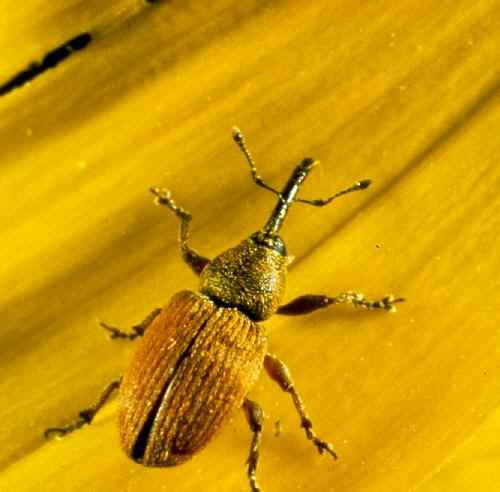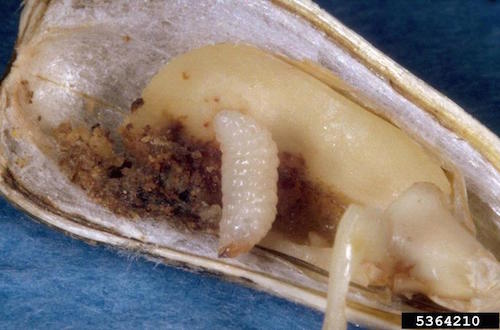Sunflower Insects
Red Sunflower Seed Weevil, Smicronyx fulvus (Coleoptera: Curculionidae).

Adult red seed weevil.

Larva revealed within seed.
Identification
This is a small, reddish-brown weevil that is 3.0 – 4.0 mm (1/8 inches) long. Adults are most easily seen on the faces of blooming sunflowers feeding on pollen, or hiding behind the flower bracts. Infested seeds are not noticably different from healthy ones, but will display an exit hole near the top once the larva has matured and left.
Life History and Behavior
There is a single generation per year, with mature larvae overwintering in the soil and pupating in mid-summer. The peak of adult emergence typically occurs mid-July to early August. Adult weevils seek sunflowers in bloom and females must feed on pollen for at least four days before they can produce eggs. Each egg is laid directly into a seed and this requires a seed in the appropriate developmental stage, creating a predicatable time frame for oviposition within every field. Few seeds are suitable for oviposition before the flower reaches R5.4 (40% of florets sheeding pollen) and, once anthesis is complete, most seeds are too hard.
Developing larvae do not usually consume the seed completely, but significantly reduce kernel weight and oil content. The time frame of larval development is such that a percentage of larvae may still be present in seed at harvest, leading to temperature and moisture problems in storage. Since the weight of infested seed is not altered significantly, it is not removed by conventional threshing or cleaning. Although live larvae will eventually exit seeds, dead larvae remain and can result in downgrading.
Management
Since the red seed weevil is a relatively late-emerging insect, earlier planting dates tend to reduce damage, but manipulation of planting date alone cannot be relied upon to provide control. Although tillage has been shown to reduce survival of overwintering weevils, it is not advisable in regions where soil moisture conservations is a concern. While treatments directed at control of sunflower moth typically coincide with periods of weevil activity and may provide simultaneous control of both pests, fields should be scouted for red seed weevil before any treatment is directed specifically at pest. This should be done as the field approaches 85 % bloom, or when 80 % of plants are past the R4 stage. Walking in a large ‘X’ pattern is recommended to ensure that samples are not taken preferentially from field borders that tend to collect higher numbers of weevils. Count the weevils on the faces of five of the most mature flowers at each of five sites. This procress can be facilitated by spraying the faces of each flower with a DEET-containing mosquito repellent that will cause weevils to quickly exit the flower.
Detailed formulae have been developed to calculate economic thresholds (numbers of adult weevils per flower) that justify treatment of both oilseed and confection sunflowers and take into account application costs and projected crop value. In general, the threshold for oilseed sunflowers falls somewhere between 10 and 20 weevils per flower, but the threshold is much lower for confection sunflowers (usually 1 or 2 weevils per flower) because of industry standards that demand seed damage remain below 3-4 % of kernels. Research suggests that approximately 27 damaged kernels result for every adult weevil observed at the early bloom stage. An early treatment should be followed by continued scouting at 4-5 day intervals, as adult emergence continues over several weeks.
Please refer to the most recent version of the Sunflower Insect Management Guide for control options.
More detailed information on the life history and biology of sunflower seed weevils can be found in KSRE publication MF3129.
Page last updated 4/01/2014 by J.P. Michaud.